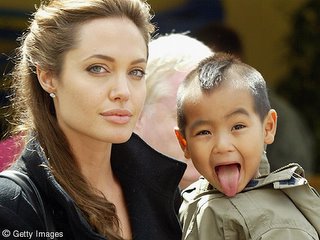 It is a familiar refrain: “Why did you adopt from China, when so many children need homes here in the U.S.?” A recent question in “Parade Magazine” posed the same question this way (Sunday, January 29, 2005):
It is a familiar refrain: “Why did you adopt from China, when so many children need homes here in the U.S.?” A recent question in “Parade Magazine” posed the same question this way (Sunday, January 29, 2005):Q: Why do stars like Brad Pitt and Angelina Jolie adopt foreign kids when many are waiting here?
Parade’s answer was: In Hollywood, it's fashionable to adopt infants from the Third World. "Also, many believe there's less red tape outside the U.S. Often it's worse," explains actor Henry Winkler. He works with the Children's Action Network, which says 119,000 foster-care kids in the US are eligible for adoption.
How many children are truly available for adoption in the U.S.? An analysis of the U.S. government’s most recent statistics shows the following (2003):
In 2003 (the most recent year for which information is available) there were 25,070 children under the age of one year in the foster care program. There was an additional 129,000 children between one year and five years in the program. There are of course many more children older than 5 in the foster care program, but we will limit our discussion to this population of kids, because it is the age group most attractive for adopting parents.
An important point to keep in mind, however, is that not all of the children in the foster care program are eligible for adoption. The U.S. foster care program serves many purposes, primary of which is child protection. Most of the children (55%) in the program will end up being reunited with their birth parents, an outcome that is preferred. An additional 11% end up living with relatives. In 2003, only 18% ended up being adopted by an unrelated family.
Because reunification is a primary goal of the foster care program, States have established set evaluation timeframes for birth parents to regain custody of their children. This period prevents young children from being adopted quickly, and therefore very few children under the age of 1 year are available for adoption. Although Mr. Winkler correctly quotes a figure of 119,000 children being available for adoption, it is instructive to see how that number breaks down.
Of the 119,000 children available for adoption in 2003, only 3,850 children were under a year old (3%). An additional 38,200 (32%) children between the age of one year and five years were available for adoption, but almost certainly the majority of children were four- or five-year olds. The majority of the children available for adoption were between six and fifteen years of age (58%).
Thus, if a family desires to adopt a young infant or toddler, there are few opportunities available in the U.S. foster care program. In fact, the vast majority of adoptable children are in excess of five years old, with the median age being over ten years old.
These children need homes, of that there is no doubt. In a perfect world every child, regardless of his or her age, would be adopted into a loving family. But in the real world, the vast majority of couples looking to build a family seek for a variety of reasons to adopt a child that is as young as possible. The U.S. foster care program is ill equipped to provide the numbers of babies desired by adopting families. Thus, most are forced to look overseas, or to arrange for private adoptions (which bring in many ethical problems also).
In addition, there are serious concerns on the part of adoptive parents when it comes to adopting a child from the foster care program. Several well-publicized cases in which birth parents sued and regained custody of legally adopted children has nurtured a fear that no adoptive family wants realized. Also, many adoptive families are reluctant to take on the emotional scarring that many in the foster care program have experienced. Another factor is the bureaucracy involved with adopting a child from the foster care program, which, contrary to Mr. Winkler’s assessment, is almost always more burdensome than adopting internationally.
I guess the point that bothers me most about the question asked by the reader of Parade Magazine is that it is almost always posed by those who have not adopted at all. Instead of impugning the characters of the Meg Ryans and Angelina Jolies of the world, why don’t these same people simply adopt a child from the foster care program? Calling their adoption "fashionable" demeans the great thing they, or anyone adopting a child, has done. I guess I would respond to those that ask this question, “Unless you have adopted an orphaned child from anywhere in the world, either here in the U.S. or overseas, keep your cynical questions and comments to yourself!”
Are Angelina Jolie and Meg Ryan part of a new trend in Hollywood? I certainly hope so! I applaud both women for bringing attention to the orphans of the world, wherever they are. Both women are helping to increase the acceptability of adoption, and should be praised for the attention they are bringing to this subject. The reality is that our culture holds up natural childbirth as the preferred method for gaining a family, and adoption is almost universally viewed as a second choice. Public figures like Angelina Jolie are working to change that culture, and bring the status of adoption to higher esteem. Only then will there be hope for the millions of orphaned children in the world.

